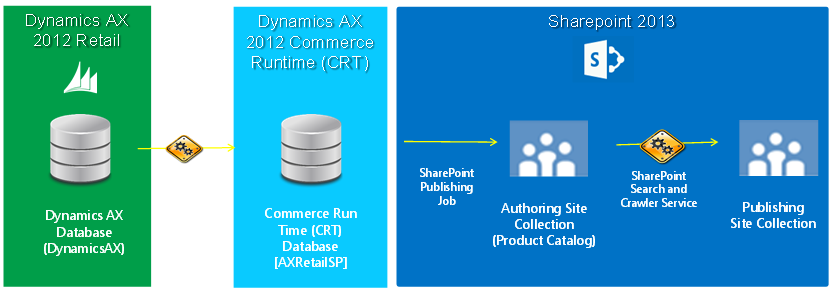Understanding the data flow process between AX and eCommerce
In a previous post I walked through how to make changes to your online web catalog directly from Dynamics AX 2012 (blogs.msdn.com/b/dynamics-coe/archive/2013/02/04/updating-your-commerce-catalog-directly-from-dynamics-ax.aspx). This powerful feature showcases the truly integrated, omni-channel retail solution that is Dynamics AX. In this post, I'm going to look at what's happening in the background and walk through the data flow of this process.
So to begin, let's have a look at a very simple picture representation of some of the components involved in this process. (and yes there are a number of elements involved that I've left off but this will get us started).
So let's step through what's happening when we publish our catalog to the web.
Step 1: Publishing the catalog from Dynamics AX to the Commerce Run Time database
When you publish the catalog in Dynamics AX and run the A-1075_OC job, the CRT Synch Service takes channel and catalog data from the Dynamics AX database and puts it into our Common Run Time (CRT) database. [In our demonstration image, this database is the AXRetailSP database]. The CRT database is created as part of the Dynamics AX Retail Commerce setup. It can be thought of as another store in the AX for Retail framework, in this case, an online store. It contains data for use by the CRT engine, including products and product hierarchy. For example, in the CRT database, there are the tables ECORESCATEGORY and ECORESPRODUCT (for those who know the Dynamics AX schema they should look familiar). There are also additional tables in there which support other functions such as publishing information, but that's a subject for another day. In short, when you've got data into the CRT DB, you're well on your way.
Step 2: Loading (Publishing) the SharePoint Authoring Site
The AX Retail Commerce framework is built using two SharePoint collection sites - one for authoring the content and the other as the external facing published site. This approach is an uptake of Microsoft SharePoint's cross-site publication functionality. Let's first of all look at the authoring site. The authoring site is built to contain the raw product information and attributes as well as the product catalog that we've been looking at. The product master and hierarchy data in this site is contained in lists and the term set and is populated from the CRT DB primarily the 'Retail Publishing Job'. This is a critical job in this process. You can view the status of this job, job history and definition in SharePoint Central Administration - Monitoring. You can see it being scheduled and executed in the below screen: (note: you'll need to be logged in with domain\administrator privileges to run some of the features in here)
So upon executing this job, what happens is that data is taken from the CRT DB and it's pulled into the product catalog (or authoring) site as lists and the term store. It also does a final status update back to Dynamics AX to keep everyone in the loop as to what's going on.
Now its SharePoint's turn to take over. ..
Step 3: Publish to the SharePoint Publishing Site
Cross-site publishing is a feature of SharePoint. The lists that we've populated in the authoring site are crawled (indexed) by SharePoint Search and as a result the data will exist in the SharePoint search DB. When the online store's web site renders the products it is done by querying the SharePoint search (which is internally accessing the SharePoint search DB).
So there you have it. As mentioned above, our truly integrated, omni-channel retail solution enables retailers to control their website data and hierarchy data directly from Dynamics by securely managing data in a controlled, secure framework as described above.
And before I sign off, big thanks to Sergey Pikhulya, who is the Yoda of this young Skywalkers' road to commerce enlightenment…
Peter is a Retail Solution Architect for the Centre of Excellence EMEA team

